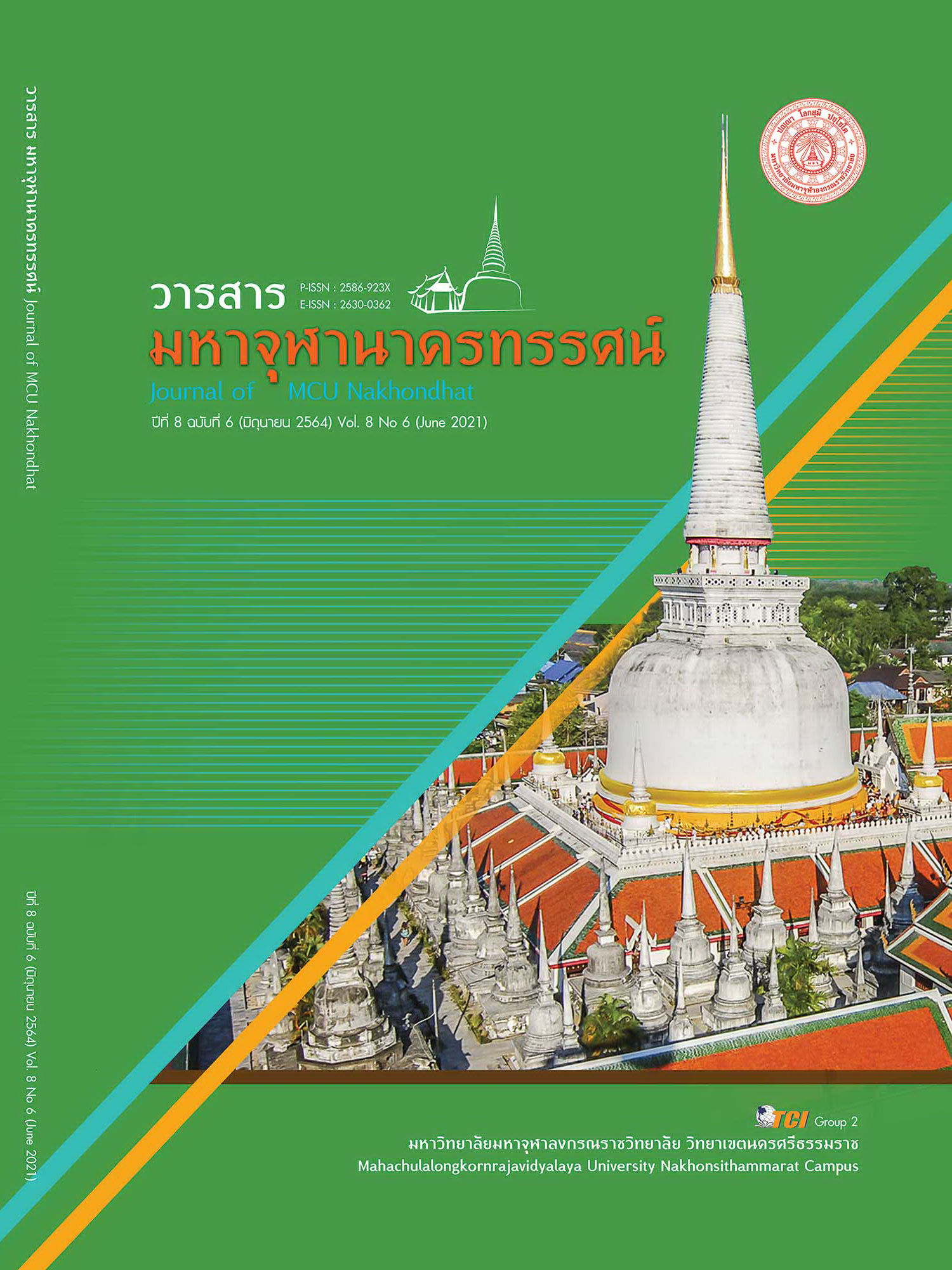THE SIX DIRECTIONS IN BUDDHISM AND THE CREATION OF A RELATIONSHIP BETWEEN PEOPLE IN THE NEW NORMAL ERA
Main Article Content
Abstract
The objective of this article is to explain the six directions in Buddhism and the creation of a new relationship between people in the new normal era. The six directions are as follows: 1) a front direction i.e., a father and a mother, 2) a right direction i.e., a teacher, 3) a back direction i.e., a husband and a wife 4) a left direction i.e., a friend 5) a lower direction i.e., an employee and an employer 6) an upper direction i.e., a priest. The above teaching can be found on Singghalaka Sutra which focuses on an application of these six directions on laities’ daily lives leading to a social relationship called ‘a society’. At present, the new way of life (New Normal) is defined by the Royal Thai Council of Communication Arts Council Royal Society as a new way of life because people’s daily lives have been affected so greatly that the typical and can be expected ways of lives cannot be predicted resulting in a new normal way. For a term ‘New Normal’ in this article, it is used In the COVID-19 context. That means there are changes of roles towards people in a society. As a Buddhist, therefore, we should review the principle of six directions and use it as a guideline to create a good personal relationship among people in a society. This principle still maintains the concept of rights to thinking, values, and other measures of self-conduct encouraging the changes based on the reality in a society.
Article Details
References
ธาดา ราชกิจ. (2562). การสร้างมนุษยสัมพันธ์ในองค์กร. เรียกใช้เมื่อ 14 เมษายน 2564 จาก https://th.hrnote.asia/orgdevelopment/190523-human-relation-organization
ปัญญานันทภิกขุ. (2525). หน้าที่ของคน. กรุงเทพมหานคร: ธรรมสภา.
พชร ช่วยเกื้อ. (2561). ทิศ 6. (พิมพ์ครั้งที่ 6). กรุงเทพมหานคร: พี เอ็น เค แอนด์ สกายพริ้นติ้งส์.
พระพรหมคุณาภรณ์ (ป.อ.ปยุตฺโต). (2544). พจนานุกรมพุทธศาสตร์ ฉบับประมวลธรรม. (พิมพ์ครั้งที่ 13).กรุงเทพมหานคร: เอส. อาร์. พริ้นติ้ง แมสโปรดักส์.
. (2553). พจนานุกรมพุทธศาสน์ ฉบับประมวลศัพท์. (พิมพ์ครั้งที่ 14).กรุงเทพมหานคร: ธนธัชการพิมพ์.
พระไพศาล วิสาโล. (2552). พลวัตของศาสนาในยุคโลกาภิวัตน์. เรียกใช้เมื่อ 14 เมษายน 2564 จาก https://www.visalo.org/article/budPolawat.htm
พระมหาอดิศร ถิรสีโล. (2540). คุณธรรมสำหรับครู. กรุงเทพมหานคร: โอเดียนสโตร์.
พระสมชาย ฐานวุฑโฒ. (2543). มงคลชีวิตธรรมทายาท. กรุงเทพมหานคร: ฐานการพิมพ์.
พันตรี ป.หลงสมบูรณ์. (2540). พจนานุกรม มคธ-ไทย. กรุงเทพมหานคร: อาทรการพิมพ์.
มหาจุฬาลงกรณราชวิทยาลัย. (2539). พระไตรปิฎกภาษาไทย ฉบับมหาจุฬาลงกรณราชวิทยาลัย. กรุงเทพมหานคร: มหาจุฬาลงกรณราชวิทยาลัย.
มูลนิธิภูมิพโลภิกขุ. (2532). พจนานุกรมบาลี -ไทย อังกฤษ. กรุงเทพมหานคร: โรงพิมพ์มูลนิธิภูมิพโลภิกขุ.
ราชบัณฑิตยสถาน. (2546). พจนานุกรมฉบับราชบัณฑิตยสถาน พ.ศ. 2542. กรุงเทพมหานคร: บริษัทนาน มีบุ๊คส์พับลิเคชั่นส์.
ลักขณา สริวัฒน์. (2556). มนุษยสัมพันธ์. กรุงเทพมหานคร: โอเดียนสโตร์.
สุขุมพงษ์ ชาญนุวงศ์. (2555). นี้แหละ...คือสิ่งที่พระพุทธเจ้าสอนให้ไอน์สไตน์ฉลาดและมีความสุข. กรุงเทพมหานคร: สำนักพิมพ์ธิงค์ บิยอนด์.
อดุลศักดิ์ ทองดี. (2546). การพัฒนาวินัยในด้านการแต่งกายของนักเรียนโรงเรียนบ้านกลาง อำเภอกุฉินารายณ์ จังหวัดกาฬสินธุ์ โดยใช้กระบวนการมีส่วนร่วมของชุมชน. ใน การศึกษาค้นคว้าอิสระ การศึกษามหาบัณฑิต. มหาวิทยาลัยมหาสารคาม.
อำนวย แสงสว่าง. (2544). การจัดการทรัพยากรมนุษย์. (พิมพ์ครั้งที่ 2). กรุงเทพมหานคร: ทิพยวิสุทธิ์.
เอมอร กฤษณะรังสรรค์. (2557). การเสริมสร้างความสุขในการทำงานของพนักงานในสถาบันอุดมศึกษา: กรณีศึกษามหาวิทยาลัยศิลปากร วิทยาเขตพระราชวังสนามจันทร์. วารสารวิชาการ Veridian E-Journal , 7(1), 166-180.
Aristotle. (1962). Nicomachean Ethics Translated by Martin Ostwald. Indianapolis: Bobbs-Merrill.
Johnson, D. W. (1997). Reaching Out : Interpersonal Effectiveness and Self-Actualization. (6th ed.). Boston: Allyn and Bacon.
Keith, D. & Newstrom, J. W. (1985). Human Behavior at Work : Organizational Behavior. (7th ed.). New York: McGraw-Hill.


